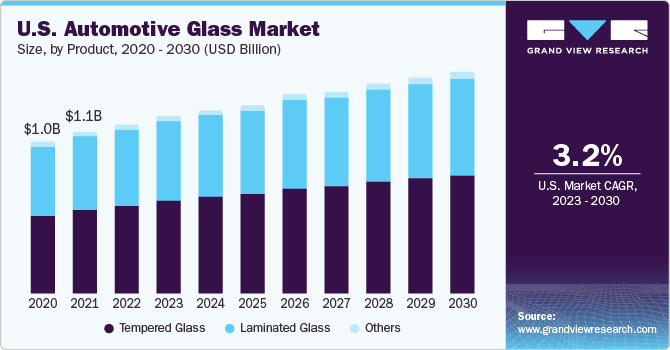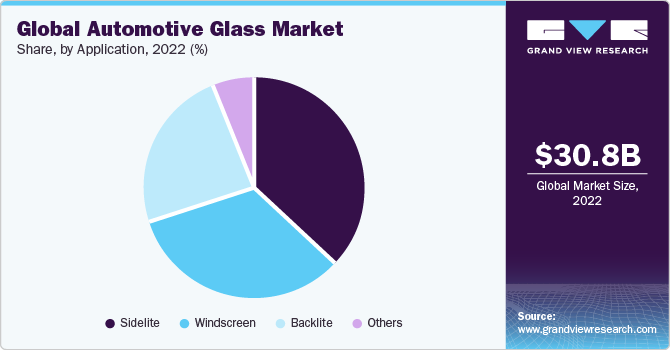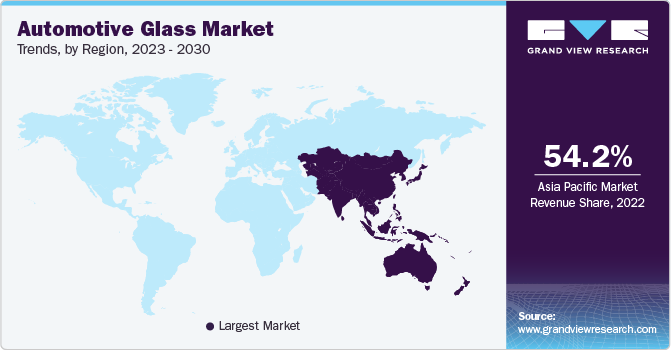
Automotive Glass Market Size, Share & Trends Analysis Report By Product (Tempered Glass, Laminated Glass, Others), By Vehicle Type, By Application, By End-use, By Region, And Segment Forecasts, 2023 - 2030
- Report ID: GVR-1-68038-234-1
- Number of Report Pages: 129
- Format: PDF, Horizon Databook
- Historical Range: 2018 - 2021
- Forecast Period: 2023 - 2030
- Industry: Advanced Materials
Automotive Glass Market Size & Trends
The global automotive glass market size was valued at USD 30.8 billion in 2022 and is anticipated to grow at a compound annual growth rate (CAGR) of 5.1% from 2023 to 2030. An increasing emphasis on lightweight cars on account of rising harmful emissions from vehicles that have an adverse effect on the environment is driving glass penetration in the automotive industry. According to the International Organization of Motor Vehicle Manufacturers (OICA), the production of automobiles reached 85.02 million vehicles globally in 2022. The strong production volume is attributed to the development of the automotive manufacturing sector, particularly in countries such as China and India, owing to increasing government initiatives regarding motor vehicle regulations.

Technological advancements in the automotive sector, along with continuous upgradation in vehicle designs, have compelled market players to introduce advanced products for automotive manufacturers. For instance, in FY 2018-2019, AIS Glass in India offered its products to various new car models with several innovative changes, including solar green glass and acoustic PVB, for the Toyota Yaris and a 2.8mm backlite for the new Wagon R.
The rise in the production of electric vehicles and the incorporation of various new technologies in terms of display and battery are expected to have a positive influence on the demand for automotive glass over the forecast period. For instance, in June 2019, Lightyear, a Dutch company, introduced the first prototype of its electric car called the Lightyear One, which has five square meters of integrated solar cells beneath the roof and hood. These solar panels are produced from safety glass and can recharge directly from the sun.
The major challenge for the market is concerning the raw materials required to produce glass. Raw materials and energy utilization account for a major share in the cost structure of glass and their supply has a direct impact on glass production and its prices. For instance, the price of a key raw material, soda ash, has witnessed a constant increase over the past few months, one of the reasons being its limited supply. In order to remedy this situation, soda ash manufacturers are increasing their production capacities to fulfill the demand from key markets such as automotive glass, chemicals, and industrial products.
Growing emphasis on fuel efficiency and reduction in harmful emissions from vehicles has led to increased production of lightweight and electric vehicles. This is anticipated to boost the demand for glass in the automotive industry in the coming years. The automotive industry has been witnessing significant technological innovations over the past many years.
Despite the decline in the overall production of vehicles, the demand for automotive glass is anticipated to remain steady over the forecast period due to the increasing production of commercial vehicles and electric cars. The rising production of commercial vehicles is a positive sign for the global market for automotive glass. In addition, a significant rise in the production of EVs is further anticipated to provide lucrative opportunities for the growth of the automotive glass industry.
Along with advancements in vehicles, such as the transition from fuel-based to electric and from manual to automatic, technological developments are also being witnessed in the case of glass, such as the dimmable and display glass technology by Gentex Corporation. The company introduced a full-display mirror, which turns the rearview mirror into a screen. This can be seen in the Chevy Bolt EV.
Furthermore, solar technology is being increasingly incorporated into the automotive industry and is anticipated to be an excellent feature in electric cars over the coming years. In 2019, Lightyear, a car company founded in 2016, launched the first prototype of its electric vehicle, the Lightyear One. The car is covered in solar panels on the roof and hood. The company claims that the solar panels are capable of charging the car battery with up to 12 kilometers of range per hour.
Rapidly changing consumer demand has led to numerous advancements in the technology used in automotive glass products. Moreover, the ascending demand for sunroofs in recent years has led to an increase in the utilization of automotive glass. A high consumer focus on luxury is expected to propel innovation in vehicles. Today, automotive manufacturers offer either built-in or optional sunroof systems, especially in mid and premium car segments, which, in turn, is anticipated to propel the demand for automotive glass over the forecast period.
The growth of the market for automotive glass is, however, restricted by one key disadvantage in the form of high manufacturing costs. Over 90% of the world’s automotive glass is manufactured by the float glass process. Float glass plants require significantly large capital to become functional and only turn out to be profitable if working at a capacity utilization of over 70%. A major share of the overall cost structure of automotive glass is accounted for by its raw material and energy consumption.
Product Insights
The tempered glass segment accounted for the largest revenue share of 59.1% in 2022 in the automotive glass industry. Its large share is attributed to factors including low cost, high strength, and robustness. The product holds a strength that is 4-5 times greater than a basic float and is more cost-effective than laminated automotive glass. As a result, it is the most preferred type of glass in automotive, particularly for windows and backlites.
The laminated glass segment is expected to advance at the fastest CAGR of 5.3% during the forecast period. The structure consists of a PVB layer sandwiched between two glass layers. It mainly finds application in windscreens owing to safety characteristics that allow it to stay intact even after accidents occur, which prevents the passengers in the vehicle from getting hurt or injured. It is preferred for sunroofs as well, which is expected to drive segment growth. Companies such as Volvo, Ferrari, and Tesla use laminated glass in all their cars that have panoramic sunroofs.
Vehicle Type Insights
The passenger cars segment accounted for the largest revenue share of 58.8% in 2022. This is attributed to factors such as changing consumer trends, the steadily growing middle-class population, and increasing environmental concerns leading to the demand for low-emission and lightweight vehicles on roads. On the other hand, the light commercial vehicles segment is expected to register the fastest CAGR of 5.3% over the forecast period. Commercial vehicles are expected to register a rapid growth in demand, owing to the surge in transportation and construction activities.
Automotive manufacturers are compelled to increase their production to cater to the growing demand. For instance, in October 2019, VE Commercial Vehicles Ltd announced an investment in its new 150-acre plant in Bhopal, Madhya Pradesh, India, in line with BS-VI norms. Companies plan to increase the production of commercial vehicles since larger vehicles prove to be profitable to manufacturers and dealers due to higher profit margins. In June 2019, GM announced a USD 150 million investment for boosting the production of heavy-duty pickup trucks at its Flint Assembly Plant in Michigan, U.S.
End-use Insights
The OEM segment accounted for the largest revenue share of 91.0% in 2022, as the majority of automotive glass is used for the production of vehicles. The OEM segment is anticipated to register a significant growth rate in the coming years, owing to the establishment of new automotive plants, particularly for electric vehicles. For instance, Tesla’s factory in Shanghai, China delivered its first 15 Model 3 cars in December 2019.
The aftermarket segment is driven by factors such as the high use of old vehicles, the need for maintenance and upgradation for these vehicles, and increasing road accidents. The segment is expected to register the fastest CAGR of 5.8% over the forecast period. Increasing cases of road traffic accidents globally, coupled with high vehicle production, are anticipated to boost the consumption of glass in the automotive aftermarket. The rising popularity of car rental services is projected to further propel segment growth, as new fleet owners have raised the maintenance standards of vehicles. This has led glass suppliers to develop dedicated offerings for fleet owners, along with customized solutions.
Application Insights
The windscreen segment held a significant revenue share of 33.4% in 2022. Windscreen carries significant importance in a vehicle structure; hence, both automotive and glass manufacturers are engaged in developing new technologies for enhancing its appearance and features. For instance, the introduction of new types of windshields with self-cleaning glass is anticipated to drive segment growth over the forecast period.

The sidelite segment is expected to advance at a CAGR of 5.4% over the forecast period. For several years, automotive manufacturers have preferred tempered glass for sidelites or the side windows of cars. The sidelite segment is expected to outpace windscreen in terms of volume demand by 2030. Increased utilization of tempered automotive glass in sidelites, particularly in the aftermarket, is anticipated to propel market growth in the coming years. The increasing number of road accidents are a primary reason for the growing use of glass in the automotive aftermarket. As a safety implementation, manufacturers are now switching to laminated glass for side windows to prevent severe injuries in case of accidents with a heavy impact.
Regional Insights
Asia Pacific dominated the market and accounted for the largest revenue share of 54.2% in 2022. This can be attributed to the high economic growth, rising disposable income, and subsequent increase in the demand for commercial vehicles in the region. Moreover, rising investments in the automotive industry are propelling the growth of the regional market for automotive glass.

Countries such as China and India have been witnessing changing consumer demands in terms of vehicle styling, safety, and comfort. This has led to a high focus among manufacturers on enhancing their efficiency in order to meet the rising vehicle demand. Asia Pacific has been witnessing a high demand for premium vehicles on account of changing consumer lifestyles and rising disposable income. This has led to an increase in the production of vehicles with sunroofs, thereby positively affecting market growth.
North America is expected to advance at a CAGR of 3.4% during the forecast period. The region has been witnessing a significant increase in the sale of commercial vehicles, which is anticipated to play a major role in propelling the demand for automotive glass in the coming years. Value-added features such as solar control, de-icing & de-misting, integrated antennas, and integrated rain and light sensors for automatic wiper or headlight activation, are being included by manufacturers to offer differentiated products and drive profit.
In February 2023, auto glass shop proprietors in the U.S. witnessed a notable upsurge in the demand for auto glass, which was primarily attributed to a surge in incidents of vehicle break-ins and a shortage of supplies that has persisted since the onset of the COVID-19 pandemic. Auto glass retailers are currently facing a challenging situation as they navigate the combined impact of shipment delays and an increased incidence of vehicle break-ins.
The U.S. has one of the largest automotive markets in the world. The applications of automotive glass in the U.S. are highly technical in nature, owing to continuous technological advancements. The presence of numerous glass & car manufacturers is expected to play a key role in fueling the demand for automotive glass in the economy. Technological advancements, high consumer disposable income, and luxurious lifestyle practices are anticipated to have a positive impact on the demand over the coming years.
Key Companies & Market Share Insights
The market relies heavily on raw material manufacturers, suppliers, distributors, manufacturers, and end-users. Despite the presence of several players in the industry, the market is consolidated in nature owing to few major manufacturers such as AGC Ltd., Saint-Gobain, Fuyao Glass Industry Group Co., Ltd., and NSG Group.
Leading manufacturers are engaged in the development and implementation of new strategies for increasing their market share. Apart from capacity expansions, mergers, acquisitions, and new product developments, integration across different stages of the value chain is a major strategy adopted by key players to help them gain a competitive advantage over other manufacturers.
Key Automotive Glass Companies:
- AGC Inc.
- Fuyao Glass Industry Group Co., Ltd.
- Nippon Sheet Glass Co., Ltd.
- Saint-Gobain
- Xinyi Glass Holdings Limited
- Vitro
- Central Glass Co., Ltd.
- Corning Incorporated
- Guardian Industries
- TAIWAN GLASS IND. CORP.
- Şişecam
Recent Developments
-
In May 2022, NSG Group announced its intention to integrate its automotive glass business in China with SYP Kangqiao Autoglass Co., Ltd., a leading manufacturer of automotive glass in China. This strategic integration with SYP Automotive aims to strengthen NSG Group's capacity to effectively cater to the increasing demands from automobile manufacturers in the Chinese market
-
In March 2022, LKQ Corporation reached an agreement to sell PGW Auto Glass to One Equity Partners (OEP), a private equity firm. As per its website, PGW boasts of an extensive network comprising over 100 distribution branches and customers totaling more than 27,000 in Canada and the U.S.
-
In February 2019, an automotive-glass manufacturer in North America, Vitro, committed a substantial investment of USD 60 million towards the development and implementation of cutting-edge technologies. These investments were strategically targeted at the North American market, aiming to enhance Vitro's dominant position in the automotive glass sector. The company intended to strengthen its role as a premier supplier to OEMs and aftermarket customers in the region
Automotive Glass Market Report Scope
|
Report Attribute |
Details |
|
Market size value in 2023 |
USD 32.82 billion |
|
Revenue forecast in 2030 |
USD 46.39 billion |
|
Growth rate |
CAGR of 5.1% from 2023 to 2030 |
|
Base year for estimation |
2022 |
|
Historical data |
2018 - 2021 |
|
Forecast period |
2023 - 2030 |
|
Report updated |
October 2023 |
|
Quantitative units |
Revenue in USD million, volume in thousand sq. meters, and CAGR from 2023 to 2030 |
|
Report coverage |
Revenue forecast, company ranking, competitive landscape, growth factors, and trends |
|
Segments covered |
Product, vehicle type, application, end-use, region |
|
Regional scope |
North America; Europe; Asia Pacific; Latin America; MEA |
|
Country scope |
U.S.; Canada; Mexico; U.K.; Germany; France; Italy; Spain; Turkey; China; Japan; India; Australia; South Korea; Thailand; Indonesia; Malaysia; Brazil; Argentina; South Africa; Morocco |
|
Key companies profiled |
AGC Inc.; Fuyao Glass Industry Group Co., Ltd.; Nippon Sheet Glass Co., Ltd.; Saint-Gobain; Xinyi Glass Holdings Limited; Vitro; Central Glass Co., Ltd.; Corning Incorporated; Guardian Industries; TAIWAN GLASS IND. CORP.; Şişecam |
|
Customization scope |
Free report customization (equivalent up to 8 analyst’s working days) with purchase. Addition or alteration to country, regional & segment scope |
|
Pricing and purchase options |
Avail customized purchase options to meet your exact research needs. Explore purchase options |
Global Automotive Glass Market Report Segmentation
This report forecasts revenue and volume growth at the global, regional, and country levels and provides an analysis of the latest industry trends in each of the sub-segments from 2018 to 2030. For the purpose of this study, Grand View Research has segmented the global automotive glass market report based on product, vehicle type, application, end-use, and region:
-
Product Outlook (Revenue, USD Million; Volume, Thousand Square Meters, 2018 - 2030)
-
Tempered Glass
-
Laminated Glass
-
Others
-
-
Vehicle Type Outlook (Revenue, USD Million; Volume, Thousand Square Meters, 2018 - 2030)
-
Passenger Cars
-
Light Commercial Vehicles
-
Heavy Commercial Vehicles
-
-
Application Outlook (Revenue, USD Million; Volume, Thousand Square Meters, 2018 - 2030)
-
Windscreen
-
Backlite
-
Sidelite
-
Others
-
-
End-use Outlook (Revenue, USD Million; Volume, Thousand Square Meters, 2018 - 2030)
-
Original Equipment Manufacturer (OEM)
-
Aftermarket
-
-
Regional Outlook (Revenue, USD Million; Volume, Thousand Square Meters, 2018 - 2030)
-
North America
-
U.S.
-
Canada
-
Mexico
-
-
Europe
-
UK
-
Germany
-
France
-
Italy
-
Spain
-
Turkey
-
-
Asia Pacific
-
China
-
Japan
-
India
-
Australia
-
Thailand
-
South Korea
-
Indonesia
-
Malaysia
-
-
Latin America
-
Brazil
-
Argentina
-
-
Middle East and Africa
-
South Africa
-
Morocco
-
-
Frequently Asked Questions About This Report
b. The global automotive glass market size was estimated at USD 30.8 billion in 2022 and is expected to reach USD 32.82 billion in 2023.
b. The global automotive glass market is expected to grow at a compound annual growth rate of 5.2% from 2023 to 2030 to reach USD 46.39 billion by 2030.
b. Asia Pacific dominated the automotive glass market with a share of over 54.0% in 2022. The share is attributed to countries like China, Japan, India, and South Korea, which together account for more than half of the global automotive production as of 2022.
b. Some key players operating in the automotive glass market include AGC Ltd., Saint-Gobain, Fuyao Glass Industry Group Co., Ltd., and NSG Group.
b. Key factors that are driving the market growth include increasing emphasis towards lightweight cars on account of rising harmful emissions from vehicles that have adverse effects on environment propelling the glass penetration in the automotive industry.
We are committed towards customer satisfaction, and quality service.
"The quality of research they have done for us has been excellent."




